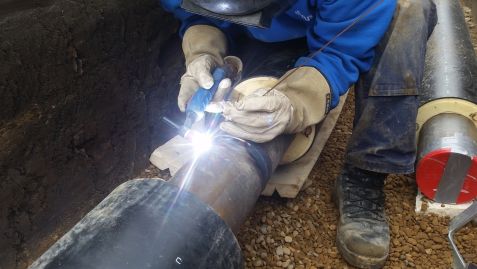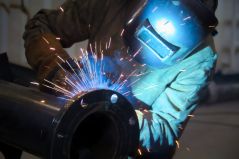MLZ is a cooperation between:
 > Technische Universität München
> Technische Universität München > Helmholtz-Zentrum Hereon
> Helmholtz-Zentrum Hereon
 > Forschungszentrum Jülich
> Forschungszentrum Jülich
MLZ is a member of:
 > LENS
> LENS > ERF-AISBL
> ERF-AISBL
MLZ on social media:

MLZ (eng)
Lichtenbergstr.1
85748 Garching
18.02.2021
Making reliable weld seams

Weld seams connect pipes together in environments that require high-safety and therefore must not fail. © adobe.stock.com
If a component is to be tight and robust, it should be welded. Simulations determine the properties of the weld in advance. To optimize the simulated calculation models for the French electricity company Électricité de France (EDF), a team of researchers at MLZ measured stress in a component after welding.
The weld seam in Tungsten Inert-Gas Welding looks like a small caterpillar. We encounter this caterpillar in everyday life, for example on stair railings or in cars. But in high-safety applications, such as reactor tubes, are also welded. Reactor tubes are just one example where it is particularly important for weld seams to hold. To ensure this, developers simulate the maximum load limit and determine the service life of welded components. However, since these simulations are theoretical calculation models, their results must be verified by experiments. And it was these experiments that Dr. Joana Rebelo Kornmeier conducted at the Heinz Maier-Leibnitz Zentrum together with colleagues from France and the Czech Republic as well as the industry association “Network on Neutron Techniques Standardization for Structural Integrity”.
Welding leads to stress
It is common practice for the weld seam of a component to be reworked after welding, for example by milling. However, the heat generated in the process causes changes in the metal. Heat distorts the regularly arranged atomic lattice, thus creating stress in the component. This stress should be avoided as much as possible because it can deform the component and, in the worst case, lead to failure. Therefore, it is important to know the stress states after welding in order to avoid or mitigate them during the development of pipelines. “These are sensitive manufacturing processes and components that must not fail under any circumstances. They are used in high-security applications, and that is why it is so important for the simulations to work reliably,” says Dr. Joana Rebelo Kornmeier.

Diffraction: With the help of the reflected or diffracted neutron beam, stress in the metal lattice can be measured. © FRM II / TUM
A look inside with neutrons
To examine the inside of the component, the researchers used the STRESS-SPEC instrument at the Heinz Maier-Leibnitz Zentrum. They used neutron diffraction to analyse the structure of the metal. In this process, the incident neutron beam hits the component and is reflected by the different lattice planes in the metal. The reflection provides information about the inside of the metal: for example, how the atoms are arranged or what the spacing between the lattice planes is. If the diffraction patterns of the reflected beam are distorted, this means that the lattice is correspondingly distorted and stress has deformed the component. The scientists compared the simulated data with the experimentally measured data and thus improved the models on which the simulations were based.
Better simulations ensure greater safety
Many industrial companies use such simulations to develop their products. For example, EDF will also use the improved simulations to make its plants safer in the future. The company came to FRM II with its request to improve the simulations and was also involved in the experiments. “We support people with such technical problems in order to solve them together,” Dr. Rebelo Kornmeier says and is pleased to have made plants safer with their investigations.
Original publication:
Rebelo Kornmeier, J. et al. Effects of finish turning on an austenitic weld investigated using diffraction methods. The International Journal of Advanced Manufacturing Technology (2020) 108:635–645
DOI: 10.1007/s00170-020-05386-8
Related News
MLZ is a cooperation between:
 > Technische Universität München
> Technische Universität München > Helmholtz-Zentrum Hereon
> Helmholtz-Zentrum Hereon
 > Forschungszentrum Jülich
> Forschungszentrum Jülich
MLZ is a member of:
 > LENS
> LENS > ERF-AISBL
> ERF-AISBL
MLZ on social media:



